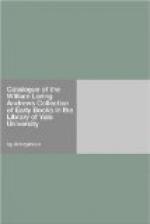Quarto. Quires [1^8, 2^{12}, 3-4^{10}, 5^{12}, 6-7^{10}, 8^{12}, 9^{14}, 10-11^{10}, 12^{12}, 13^8, 14^6, 15-19^{10}, 20^8], 202 leaves, the last two blank, roman letter, 39 lines to the page, without signatures, catchwords or pagination. Two- to six-line spaces left for capitals and spaces also for Greek words, to be supplied in manuscript. Two pinholes on side. The type is Jenson’s first font. Hain 15802. Proctor 4071.
At the head of the first page is a large initial of the interlaced vine pattern in gold and colors, with a border of the same pattern enclosing the entire page. The remaining five books, the prefatory epistle and the supplement De ego, mei et sui are introduced by initials of the same size and style. Alternate red and blue capitals at the head of chapters, paragraph-marks also in red and blue.
A few of the spaces left for Greek words are filled in manuscript, but more are left vacant. When Jenson later in the same year printed Cicero’s Letters, he was provided with Greek type. The blank fol. 9^a is occupied by a transcript in an early hand of the greater part of lib. i, cap. iv (De ficu), from a MS. the readings of which differ materially from the printed text.
For the purposes of the index the six books have been divided into a continuous series of 479 chapters, designated in the margins of the text by manuscript roman numerals, but in the index by printed numerals. The references are not, as in later editions, to book and chapter, but to chapters only. The index, alphabetized by the first letter of the word only, printed on different paper and forming a separate quire, is here placed at the beginning of the volume; but traces of earlier manuscript signatures still remaining, bear witness to a former order in which the text preceded the index, as is still the case in some copies of this edition.
Most of Jenson’s early books were folios. But notwithstanding the size of the leaf (13 x 8 in.), this is a quarto, as both the direction of the chain-lines and the position of the water-mark prove. However, because of the limitations of the early presses, it was doubtless printed on half-sheets, folio-wise, two pages at most at one impression.
Of the twenty-four 15th-century editions of the Elegantiae the three earliest, one of which was Jenson’s, were printed in 1471.
Although the tradition that Nicolas Jenson, master of the mint at Tours, was sent by Charles VII. in 1458 to Mainz to learn the secrets of the newly discovered art of printing is otherwise unsupported and, in view of the manner in which the invention was afterwards carried to France as well as to other countries by private initiative, improbable, he was already a master of the art, wherever and however acquired, when he established in 1470 the press which held the leading place at Venice until his death in 1480.
The present exceptionally fine copy of the Elegantiae, bound in citron morocco, with gold borders and gilt edges, is the Wodhull copy, bought in 1786 of Payne for L10.10s.




